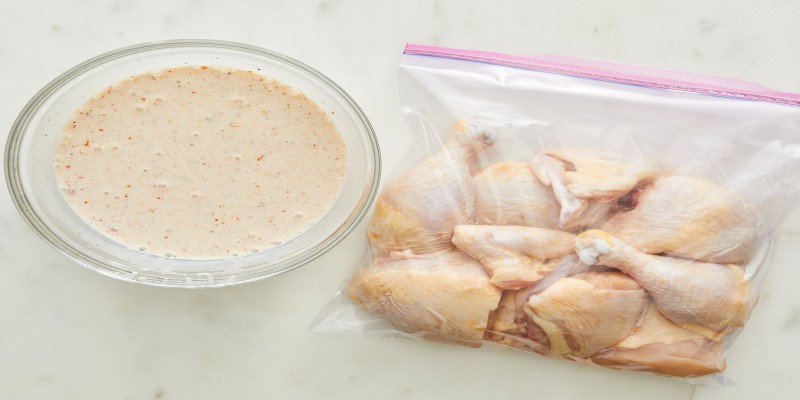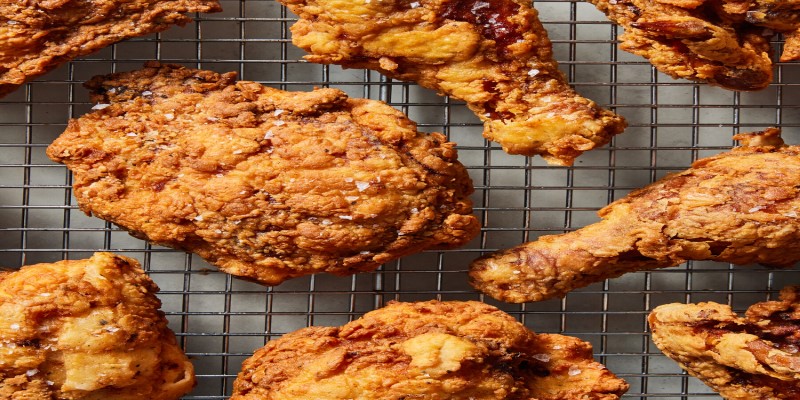The Secret to Crispy Yet Tender Fried Chicken
Who doesn't love fried chicken? That golden, crunchy crust paired with juicy, tender meat is irresistible. But let's be honest—making fried chicken at home that's just as good as your favourite restaurants can be tricky. Sometimes, it turns out to be too dry, the coating doesn't stick, and it's plain greasy.
Who doesn't love fried chicken? That golden, crunchy crust paired with juicy, tender meat is irresistible. But let's be honest—making fried chicken at home that's just as good as your favourite restaurants can be tricky. Sometimes, it turns out to be too dry, the coating doesn't stick, and it's plain greasy.
So, what's the secret? How do chefs get that perfect balance of crunch and tenderness every time? It all comes down to combining the proper techniques, ingredients, and a few game-changing tricks. If you've struggled to make flawless fried chicken at home, this guide is for you. We'll break down each step so you can achieve golden perfection in your kitchen.
Picking the Right Chicken Matters
Let's start with the foundation—your chicken. Not all cuts are equally suited for frying; choosing the right one can make or break your dish.
Bone-in, skin-on chicken
It is the best option. The skin helps create a crispier texture, while the bones help retain moisture, keeping the meat juicy even after frying.
Thighs and drumsticks
These are the most forgiving cuts. Their higher fat content means they stay tender even if cooked slightly longer.
Chicken breasts
It can be used, but they tend to dry out faster. If you prefer white meat, consider cutting the breasts into smaller pieces and bringing them beforehand.
The Secret to Juicy Fried Chicken: Brining and Marinating
One of the biggest mistakes people make is frying chicken straight from the fridge. If you want genuinely tender beef, you must brine or marinate the meat first. This step helps lock in moisture, ensuring the chicken stays juicy even after being fried at high temperatures.
Option 1: Buttermilk Marinade (The Southern Classic)
If you’ve ever wondered why Southern fried chicken is so incredibly tender, the secret is buttermilk. Buttermilk contains mild acids that help break down the proteins in the meat, making it more tender. It also helps the bread stick better.

How to do it:
1. In a large bowl, mix:
o 2 cups of buttermilk
o 1 tablespoon of salt
o 1 teaspoon of black pepper
o 1 teaspoon of garlic powder
o 1 teaspoon of paprika (optional for extra flavour)
2. Submerge the chicken in the buttermilk mixture.
3. Cover and refrigerate for at least 4 hours—but overnight is even better.
Option 2: Salt Brine (For Extra Moisture Retention)
If you don’t have buttermilk, a simple saltwater brine can work wonders in keeping your chicken juicy.
How to do it:
1. Dissolve ¼ cup of salt in 4 cups of water.
2. Submerge the chicken and let it sit for at least 1 hour before frying.
Both methods work well, but the buttermilk marinade adds extra flavour, while the salt brine primarily ensures juiciness.
Creating the Perfect Crispy Coating
A great crust is what separates good fried chicken from exceptional fried chicken. If you've ever had fried chicken whose coating slides off, turns soggy or lacks crunch, you'll want to pay attention to this step.
Step 1: Season Your Flour
Bland breading leads to bland fried chicken. To make sure every bite is flavorful, mix these seasonings into your flour:
• 2 cups of all-purpose flour
• 1 teaspoon of salt
• 1 teaspoon of black pepper
• 1 teaspoon of garlic powder
• 1 teaspoon of onion powder
• 1 teaspoon of paprika (for colour and depth)
• ½ teaspoon of cayenne pepper (optional for heat)
Step 2: Double Dipping for Extra Crunch
You need to double-dip your chicken if you want that textured, extra-crispy crust. Here's how:
1. Dredge the marinated chicken in the seasoned flour mixture. Shake off excess.
2. Dip it back into buttermilk (or an egg wash if you didn’t use buttermilk).
3. Coat it in the flour mixture, pressing firmly to create a craggy texture.
Double-dipping ensures a thicker, crispier crust that holds up beautifully when fried.
Pro tip: Adding a tablespoon of cornstarch or baking powder to the flour mixture makes the coating even crunchier!
Mastering the Frying Process
Now comes the most crucial step—frying the chicken. Many people go wrong here. If the oil temperature isn't right, the results can be disastrous.
Step 1: Choosing the Right Oil
You need an oil with a high smoke point that won’t break down at frying temperatures. The best choices are:
• Peanut oil (preferred for its neutral flavour and high smoke point)
• Canola oil
• Vegetable oil
• Sunflower oil
Avoid olive oil—it burns too quickly and isn’t suited for deep frying.
Step 2: Keeping the Oil at the Right Temperature
The ideal frying temperature is between 325°F and 350°F (165°C – 175°C).
• If the oil is too hot, The crust burns before the inside is fully cooked.
• If the oil is too cold, The chicken absorbs excess oil, making it greasy.
How to test without a thermometer: Drop a small piece of bread into the oil—if it sizzles and turns golden within 10-15 seconds, the oil is ready.
Step 3: Don’t Overcrowd the Pan
Frying too many pieces simultaneously lowers the oil temperature, resulting in soggy chicken. Fry in small batches to maintain consistent heat.
The Final Step: Let It Rest

You've fried your chicken to golden perfection—but don't dig in yet! Resting is an important step that many home cooks skip.
• Place the fried chicken on a wire rack instead of paper towels. This prevents it from becoming soggy.
• Let it rest for at least 5-10 minutes before serving. This allows the juices inside the meat to redistribute, ensuring every bite is tender and flavorful.
Bonus Tips for the Ultimate Fried Chicken
Want to take your fried chicken to the next level? Here are a few extra tricks:
For extra crunch
Add crushed cornflakes or panko breadcrumbs to the flour mixture.
For spicy fried chicken
Toss the freshly fried chicken in melted butter and hot sauce for a Nashville-style kick.
For extra juicy results
After frying, place the chicken in a 250°F (120°C) oven for 10 minutes to ensure the inside is fully cooked without drying out the crust.
The Secret to Fried Chicken Perfection
Making crispy, tender fried chicken isn’t just about throwing pieces into hot oil—it’s about technique. From bringing to the perfect breading, oil temperature, and resting time, every step plays a role in achieving that mouthwatering, golden perfection.
Next time you crave that classic crunch, follow these tried-and-true secrets. Your homemade fried chicken will be so good you might never return to takeout!